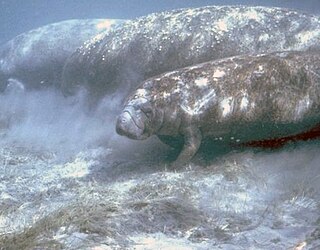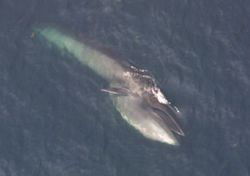Top Qs
Timeline
Chat
Perspective
List of mammals of Cuba
From Wikipedia, the free encyclopedia
Remove ads
This is a list of the mammal species recorded in Cuba. Of the mammal species in Cuba, twelve of the species listed are considered to be extinct. [1]
The following tags are used to highlight each species' conservation status as assessed by the International Union for Conservation of Nature:
| EX | Extinct | No reasonable doubt that the last individual has died. |
| EW | Extinct in the wild | Known only to survive in captivity or as a naturalized populations well outside its previous range. |
| CR | Critically endangered | The species is in imminent risk of extinction in the wild. |
| EN | Endangered | The species is facing an extremely high risk of extinction in the wild. |
| VU | Vulnerable | The species is facing a high risk of extinction in the wild. |
| NT | Near threatened | The species does not meet any of the criteria that would categorise it as risking extinction but it is likely to do so in the future. |
| LC | Least concern | There are no current identifiable risks to the species. |
| DD | Data deficient | There is inadequate information to make an assessment of the risks to this species. |
Remove ads
Order: Sirenia (manatees and dugongs)

Sirenia is an order of fully aquatic, herbivorous mammals that inhabit rivers, estuaries, coastal marine waters, swamps, and marine wetlands. All four species are endangered.
- Family: Trichechidae
- Genus: Trichechus
- West Indian manatee, T. manatus VU
- Genus: Trichechus
Order: Rodentia (rodents)

Rodents make up the largest order of mammals, with over 40% of mammalian species. They have two incisors in the upper and lower jaw which grow continually and must be kept short by gnawing. Most rodents are small though the capybara can weigh up to 45 kg (99 lb).
- Suborder: Hystricomorpha
- Family: Dasyproctidae
- Genus: Dasyprocta
- Mexican agouti, D. mexicana CR introduced
- Central American agouti, D. punctata LC introduced
- Genus: Dasyprocta
- Family: Cuniculidae
- Genus: Cuniculus
- Lowland paca, C. paca LC introduced
- Genus: Cuniculus
- Family: Capromyidae
- Subfamily: Capromyinae
- Genus: Capromys
- Desmarest's hutia, C. pilorides LC
- Genus: Mesocapromys
- Cabrera's hutia, M. angelcabrerai EN
- Eared hutia, M. auritus EN
- Dwarf hutia, M. nanus CR, possibly EX
- San Felipe hutia, M. sanfelipensis CR, possibly EX
- Genus: Mysateles
- Garrido's hutia, M. garridoi CR, possibly EX
- Gundlach's hutia, M. gundlachi VU
- Black-tailed hutia, M. melanurus VU
- Southern hutia, M. meridionalis CR
- Prehensile-tailed hutia, M. prehensilis NT
- Genus: Capromys
- Subfamily: Capromyinae
- Family: Dasyproctidae
- Suborder: Muridae
Remove ads
Order: Eulipotyphla (shrews, hedgehogs, moles, and solenodons)

Eulipotyphlans are insectivorous mammals. Shrews and solenodons closely resemble mice, hedgehogs carry spines, while moles are stout-bodied burrowers.
- Family: Solenodontidae
- Genus: Atopogale
- Cuban solenodon, A. cubana EN
- Genus: Atopogale
Order: Chiroptera (bats)
Summarize
Perspective

The bats' most distinguishing feature is that their forelimbs are developed as wings, making them the only mammals capable of flight. Bat species account for about 20% of all mammals.
- Family: Noctilionidae
- Genus: Noctilio
- Greater bulldog bat, N. leporinus LC
- Genus: Noctilio
- Family: Vespertilionidae
- Subfamily: Vespertilioninae
- Genus: Antrozous
- Pallid bat, A. pallidus LC
- Genus: Eptesicus
- Big brown bat, E. fuscus LC
- Genus: Lasiurus
- Eastern red bat, L. borealis LC
- Genus: Antrozous
- Subfamily: Vespertilioninae
- Family: Molossidae
- Genus: Eumops
- Wagner's bonneted bat, E. glaucinus LC
- Genus: Mormopterus
- Little goblin bat, M. minutus VU
- Genus: Nyctinomops
- Broad-eared bat, N. laticaudatus LC
- Big free-tailed bat, N. macrotis LC
- Genus: Tadarida
- Mexican free-tailed bat, T. brasiliensis LC
- Genus: Eumops
- Family: Mormoopidae
- Genus: Mormoops
- Antillean ghost-faced bat, M. blainvillii LC
- Ghost-faced bat, M. megalophylla LC extirpated[2]
- Genus: Pteronotus
- Macleay's mustached bat, P. macleayii LC
- Parnell's mustached bat, P. parnellii LC
- Sooty mustached bat, P. quadridens LC
- Genus: Mormoops
- Family: Phyllostomidae
- Subfamily: Phyllostominae
- Genus: Macrotus
- Waterhouse's leaf-nosed bat, M. waterhousii LC
- Genus: Macrotus
- Subfamily: Brachyphyllinae
- Genus: Brachyphylla
- Cuban fruit-eating bat, B. nana LC
- Genus: Brachyphylla
- Subfamily: Phyllonycterinae
- Genus: Erophylla
- Buffy flower bat, E. sezekorni LC
- Genus: Phyllonycteris
- Cuban flower bat, P. poeyi LC
- Genus: Erophylla
- Subfamily: Glossophaginae
- Genus: Monophyllus
- Leach's single leaf bat, M. redmani LC
- Genus: Monophyllus
- Subfamily: Stenodermatinae
- Genus: Artibeus
- Jamaican fruit bat, A. jamaicensis LC
- Genus: Phyllops
- Cuban fig-eating bat, P. falcatus LC
- Genus: Artibeus
- Subfamily: Desmodontinae
- Genus: Desmodus
- Common vampire bat, D. rotundus LC extirpated[3]
- Genus: Desmodus
- Subfamily: Phyllostominae
- Family: Natalidae
- Genus: Chilonatalus
- Cuban funnel-eared bat, C. micropus NT
- Genus: Nyctiellus
- Gervais's funnel-eared bat, N. lepidus LC
- Genus: Chilonatalus
Remove ads
Order: Cetacea (whales)
Summarize
Perspective



The order Cetacea includes whales, dolphins and porpoises. They are the mammals most fully adapted to aquatic life with a spindle-shaped nearly hairless body, protected by a thick layer of blubber, and forelimbs and tail modified to provide propulsion underwater.
- Suborder: Mysticeti
- Family: Balaenopteridae (baleen whales)
- Family: Balaenidae
- Genus: Eubalaena
- North Atlantic right whale, Eubalaena glacialis EN[4]
- Genus: Balaenoptera
- Common minke whale, B. acutorostrata LC
- Sei whale, B. borealis EN
- Bryde's whale, B. brydei DD
- Blue whale, B. musculus EN
- Genus: Megaptera
- Humpback whale, M. novaeangliae LC
- Genus: Eubalaena
- Suborder: Odontoceti
- Superfamily: Platanistoidea
- Family: Delphinidae (marine dolphins)
- Genus: Delphinus
- Short-beaked common dolphin, D. delphis LC
- Genus: Feresa
- Pygmy killer whale, F. attenuata DD
- Genus: Globicephala
- Short-finned pilot whale, G. macrorhyncus DD
- Genus: Lagenodelphis
- Fraser's dolphin, L. hosei LC
- Genus: Grampus
- Risso's dolphin, G. griseus LC
- Genus: Orcinus
- Killer whale, O. orca DD
- Genus: Peponocephala
- Melon-headed whale, P. electra DD
- Genus: Pseudorca
- False killer whale, P. crassidens DD
- Genus: Stenella
- Pantropical spotted dolphin, Stenella attenuata LC
- Clymene dolphin, S. clymene DD
- Striped dolphin, S. coeruleoalba LC
- Atlantic spotted dolphin, S. frontalis DD
- Spinner dolphin, S. longirostris DD
- Genus: Steno
- Rough-toothed dolphin, S. bredanensis LC
- Genus: Tursiops
- Common bottlenose dolphin, T. truncatus LC
- Genus: Delphinus
- Family: Physeteridae (sperm whales)
- Genus: Physeter
- Sperm whale, P. macrocephalus VU
- Genus: Physeter
- Family: Kogiidae (dwarf sperm whales)
- Genus: Kogia
- Pygmy sperm whale, K. breviceps DD
- Dwarf sperm whale, K. sima DD
- Genus: Kogia
- Family: Delphinidae (marine dolphins)
- Superfamily Ziphioidea
- Family: Ziphidae (beaked whales)
- Genus: Mesoplodon
- Gervais' beaked whale, M. europaeus DD
- Blainville's beaked whale, M. densirostris DD
- True's beaked whale, M. mirus DD
- Genus: Ziphius
- Cuvier's beaked whale, Z. cavirostris LC
- Genus: Mesoplodon
- Family: Ziphidae (beaked whales)
- Superfamily: Platanistoidea
Remove ads
Order: Carnivora (carnivorans)

There are over 260 species of carnivores, the majority of which eat meat as their primary dietary item. They have a characteristic skull shape and dentition.
- Suborder: Procyonidae
- Family: Procyonidae
- Family: Herpestidae
- Genus: Urva
- Small Indian mongoose, U. auropunctata LC introduced[5]
- Genus: Urva
Order: Artiodactyla (even-toed ungulates)

The even-toed ungulates are ungulates – hoofed animals – which bear weight equally on two (an even number) of their five toes: the third and fourth. The other three toes are either present, absent, vestigial, or pointing posteriorly.
- Family: Cervidae
- Subfamily: Capreolinae
- Genus: Odocoileus
- White-tailed deer, O. virginianus LC introduced
- Genus: Odocoileus
- Subfamily: Capreolinae
- Family Suidae (pigs)
- Family: Tayassuidae (peccaries)
- Genus: Tayassu
- White-lipped peccary, T. pecari VU introduced, extirpated[6]
- Genus: Tayassu
Remove ads
Globally extinct
The following species are globally extinct:
- Oriente cave rat, Boromys offella EX
- Torre's cave rat, Boromys torrei EX
- Cuban coney, Geocapromys columbianus EX
- Western Cuban nesophontes, Nesophontes micrus EX
- Giant solenodon, Atopogale arredondoi EX
- Cuban sloth, Acratocnus antillensis EX[7]
- Cuban giant sloth, Megalocnus rodens EX[8]
- Matthew's ground sloth, Parocnus brownii EX[9]
- Giant ghost-faced bat, Mormoops magna EX
- Anthony's fruit-eating bat, Artibeus anthonyi EX
- Lesser falcate-winged bat, Phyllops vetus EX
- Caribbean monk seal, Neomonachus tropicalis EX
Remove ads
See also
Notes
References
Wikiwand - on
Seamless Wikipedia browsing. On steroids.
Remove ads